Sunflower seed, peanuts and suet – oh my! One of the most overwhelming aspects of bird feeding is the wide variety of different bird seed and foods available online and in stores.
There are a ton of different bird seed choices. My local Menards has an entire aisle dedicated to bird food options. So, I wanted to create a free and comprehensive guide for all the foods you can feed the birds in your backyard.
According to Audubon, more than 100 bird species in North America supplement their natural diets with bird seed, suet, fruit and nectar from feeders. So, the best way to draw in a variety of birds to your yard is to offer different types of food in a variety of feeder options.
Below I’ve listed (in alphabetical order) every single type of bird feed I could think of with the birds it attracts, benefits/drawbacks and a price scale (from $ to $$$$).
Note: There are so many different bird “blend” varieties, that I’ll be skipping those. But, let me know in the comment section below if there’s a specific bird blend you’d like my two cents on.
Bark Butter – Wild Birds Unlimited
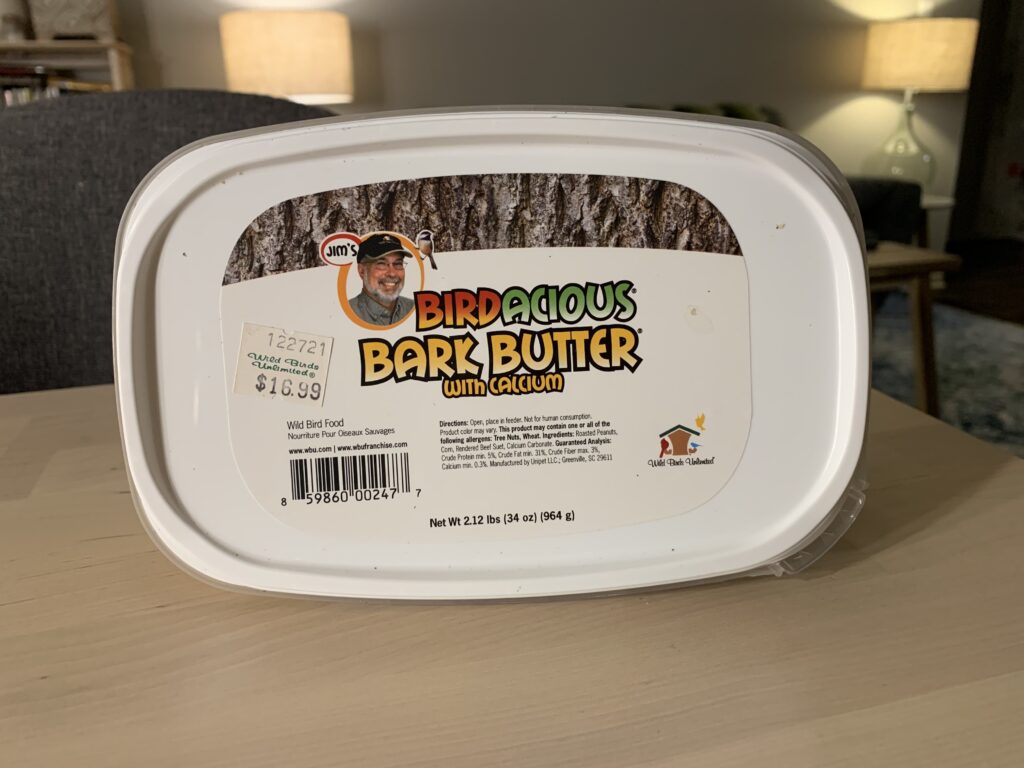
I debated adding Bark Butter to this list since it’s a specialty product. But, I’ve enjoyed using it and Wild Bird’s Unlimited stores are widespread across much of the country.
Bark Butter is a spreadable suet that can go on feeders or tree bark. It’s made from suet, peanut butter and corn with added calcium. Wild Bird’s Unlimited touts that it has attracted 152 bird species.
I’ve had a good experience with Bark Butter on my feeders so far. I haven’t tried it on tree bark (I can’t as I live in an apartment complex), but imagine that would be even better. While Bark Butter hasn’t drawn in new species to my feeders, my regular woodpeckers, chickadees, cardinals and sparrows like it.
Bark Butter is expensive (the tub I bought was $17). But, it’s worth trying at least once as birds seem to love it. Otherwise, I’d recommend regular suet as a much more affordable option. There’s also a spicy version of it to deter squirrels and they also sell Bark Butter bits with insects to draw in additional birds.
If you’re looking for an alternative to Bark Butter that you can buy on Amazon, a product called “Tree Icing” is for sale. I haven’t personally tried this product, but it has good reviews (especially for drawing in Woodpeckers).
Birds that like it:
-Brown Creepers
-Cardinals
-Chickadees
-Warblers
-Woodpeckers
-Sparrows
Here’s the full WBU list of birds that have eaten Bark Butter so far if you want to check it out.
Price: $$$$
*The Best Bird Seed – Black Oil Sunflower
This is the best bird seed you can buy. You should especially buy black oil sunflower seed if you’re just getting started with bird feeding. No other bird seed will draw in the widest variety of birds compared to sunflower seed. It has a thin shell for birds to get into and high fat and protein content for them.
Wagner’s Black Oil Sunflower Wild Bird Food, 25-Pound Bag
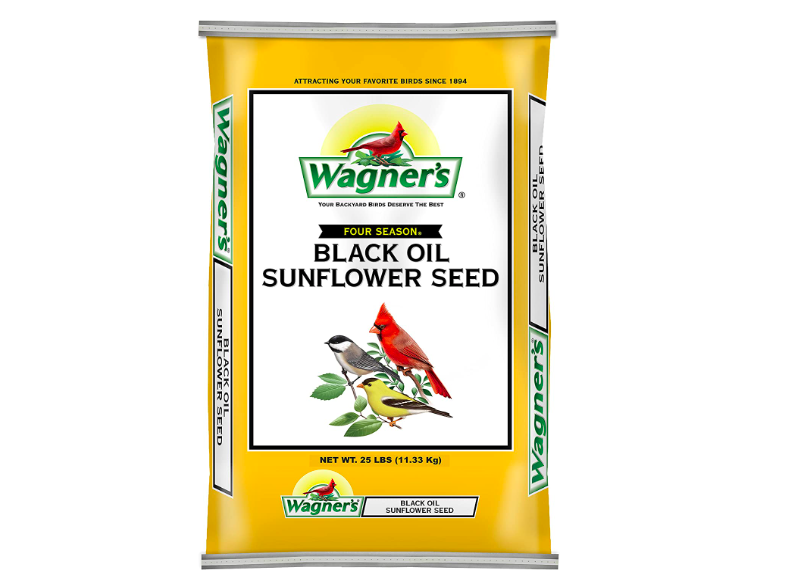
Ranking Bird Seeds from Worst to Best
Sunflower seed is also relatively cheap compared to most other bird seed. The only downside are the shell remnants left below your feeder. An easy solution to this problem is to buy sunflower chips (more information below).
If you’re having trouble with black birds swarming your feeders, you can also buy striped sunflower seed. This seed has a tougher shell to break into. So, it’s harder for pest birds to eat.
Birds that like it:
-Blue Jays
-Cardinals
-Chickadees
-Finches
-Grosbeaks
-Magpies
-Nuthatches
-Pine Siskins
-Red-Bellied Woodpeckers
-Redpolls
-Titmice
–Sparrows
Price: $$
Related: 5 Proven Ways to Attract Cardinals to a Feeder
Cracked Corn
So, I don’t love cracked corn for bird feeding, unless you’re looking to feed squirrels, ducks, turkeys, geese, and potentially blue jays (peanuts are better) from the ground. Any bird seed mix I’ve put out with cracked corn usually results in most of it being tossed on the ground.
Wagner’s Cracked Corn Wild Bird Food, 10-Pound Bag

The Cornell Bird Lab says you can mix cracked corn with white milo on the ground to draw in ground-feeding sparrows. It’s also a cost-effective way to feed critters like squirrels and chipmunks if you’d like to do that.
Cracked corn is cheap. It’s easy to buy a bunch of it. However, it also spoils quickly, especially if it gets damp. So, keep it in a dry space, and in a slightly above-ground feeder.
Birds that like it
-Blue Jays (peanuts are better)
-Canada Geese
-Cardinals (there are better options for them)
-Doves
-Ducks
-Juncos
-Sparrows
-Turkeys
Fair warning: Corn is also a magnet for many “pest birds” like Starlings, House Sparrows and Geese.
Price: $
Related: How to Start Bird Feeding in Just Two Steps
Fruit (Oranges, Apples, Grapes)

Oranges are a must-have at your bird feeding station in the spring. I’ve found that they attract Baltimore Orioles. House Finches and Woodpeckers also enjoy it as a sweet treat after they drop by for sunflower seed. You may also get lucky and draw in other species to your yard. However, this is easier said than done:
“Because few people in the United States or Canada offer fruit at feeders, few individuals of these species have experience eating at feeders, so it can be tricky to entice them to get close enough to figure out the concept.” – Cornell Bird Lab
Still, offering fruit is a fun change-up that many of your regular birds will enjoy. Apples, grapes, raisins and strawberries are all fruits I’ve offered to birds. Try dicing up leftover fruit from your pantry and put it on a platform feeder. There are also suet options that come with diced fruit mixed into them.
Birds that like it:
-Catbirds
-Cedar Waxwings
-House Finches (on occasion)
-Orioles (Oranges)
-Grosbeaks
-Mockingbirds
-Robins
-Tanagers
-Thrushes
-Woodpeckers (Oranges – on occasion)
Price: $
A couple of notes: As the weather warms, fruit and jelly (below) will spoil quickly. So, try to only put out tiny amounts at a time and clean your feeders often. These items will also draw in ants and bees. But I don’t worry too much about the bugs because some birds will also eat those. It’s bonus bird feeding food!
Grape Jelly

Just like fruit, jelly is a great sweet treat to offer birds in the spring.
Grape jelly is my top food for attracting Baltimore Orioles in the late spring into the summer, but it’s also enjoyed by several other birds. You should certainly experiment with putting it out with fruit. My favorite combo is offering orange slices and grape jelly in this Oriole feeder below. It’s an absolute home run every summer. And it’s affordable!
Birds Choice Oriolefest Feeder w/Weatherguard
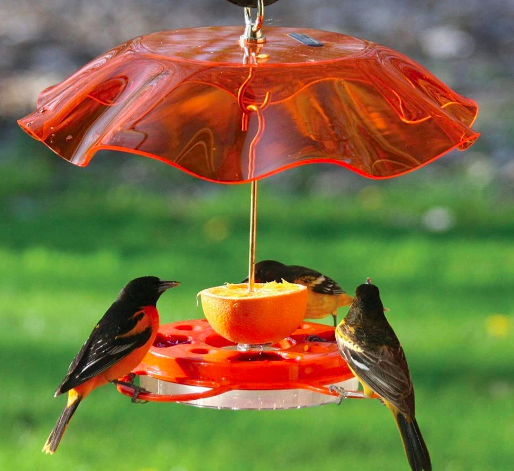
Birds that like it
-American Robins (on rare occasions)
-Gray Catbirds
-House Finches
-Orioles
-Some Warblers
-Woodpeckers
Price: $$
Note: Only offer small amounts of grape jelly at a time. If you offer too much in a big dish, it can get into a birds feathers and harm them! Keep your feeder neat and clean.
Hulled Sunflower Seed/Sunflower Chips
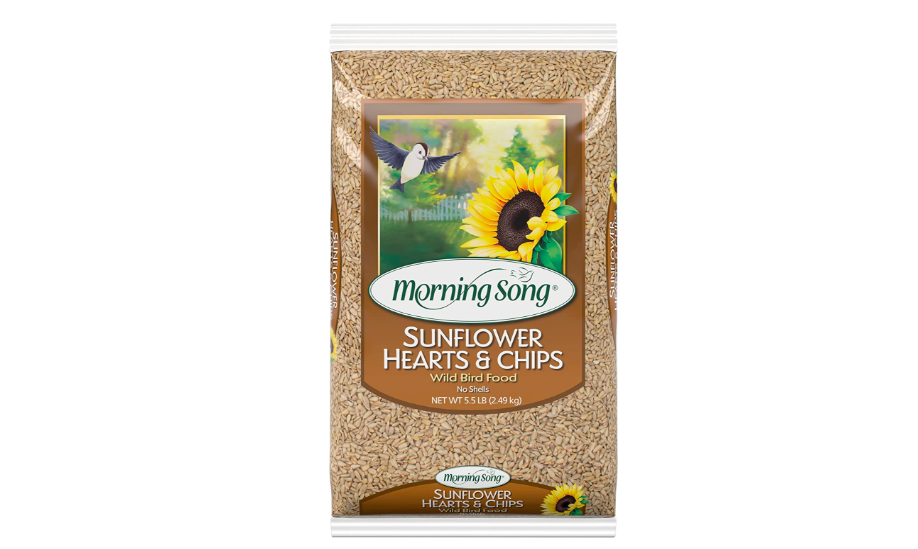
I love sunflower chips because it draws in the same birds that enjoy black oil sunflower seed without the mess! Other birds, like Goldfinches, don’t typically eat black oil sunflower seed because they have small beaks, but they’ll gladly eat sunflower chips!
Related: 4 Tips for Attracting American Goldfinches to your Yard
Sunflower chips are expensive, but I find it well worth it to save time on cleanup.
Birds that like it:
-Blue Jays
-Cardinals
-Chickadees
-Finches
-Goldfinches
-Grosbeaks
-Mourning Doves
-Nuthatches
-Pine Siskins
-Titmice
–Sparrows
-Woodpeckers (my Downy’s love it)
-Wrens
Price: $$$$
Related: Ranking the Effectiveness of Squirrel Bird Feeder Deterrents
Mealworms
Mealworms are the larva of mealworm beetles. They are a great supplemental protein addition to your bird feeding station. They’re also a good source of calcium, which is especially important for birds during mating season. Dried mealworms have quickly become the favorite choice for my regular chickadee guests. They love it!

The holy grail of putting out mealworms is to put out the live version in a curved tray to attract eastern bluebirds in the spring. It’s the only reliable food you can put out to draw them in, according to the Cornell Bird Lab. Your local bird feeding store should have them in a refrigerator. This is something I’m looking forward to trying this spring!
Birds that like it
-Bluebirds
-Cardinals
-Chickadees
-Robins (on occasion)
-Titmice
-Thrushes
-Woodpeckers
Price: $$
Fruit Mixes
Bags of fruit bird mix I purchase usually have pictures of waxwings and tropical birds on it like it’s some sort of magic elixir for hard-to-get birds at your feeder. Unless I’m doing it wrong, I’ve had no success drawing in interesting birds with these mixes.

The base of these mixes usually has something useful like peanuts and/or sunflower seeds (like the example above), so they aren’t a complete loss. I just haven’t had any luck paying a premium for this seed to draw in any unique birds. You’re much better off buying sunflower seed or peanuts to draw in birds at a cheaper price point.
Price: $$$
Oats (Garbage)
This is often found in cheap bird seeds to act as a filler. Birds don’t care for it and it offers them next to nothing nutritionally. Pass on anything containing oats.
Red Milo (Garbage)
Don’t buy this or any bird seed that contains red milo. It’s a filler seed 99% of birds will just toss to the side. PASS!
Nyjer Seed
Nyjer (aka “thistle seed”) is an awesome option for finches and chickadees. You can buy nyjer seed on its own (above) or in a “finch mix” with sunflower chips also added in.
Wagner’s Nyjer Seed Wild Bird Food, 20-Pound Bag
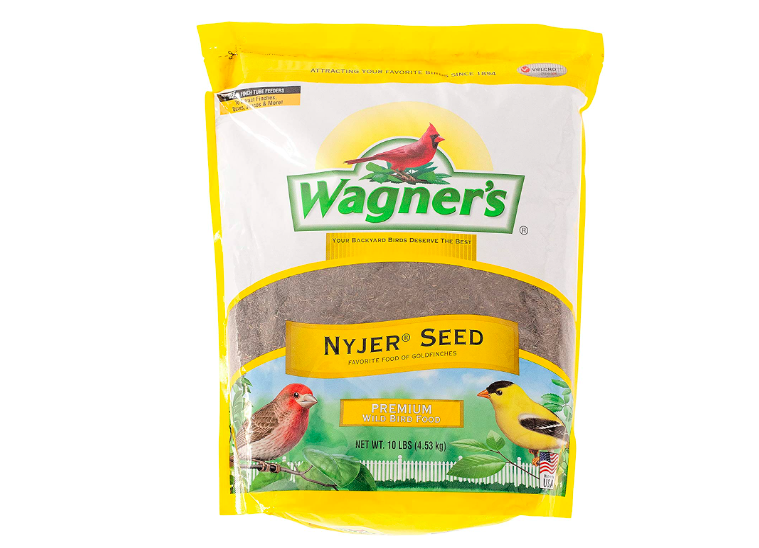
Nyjer is expensive and it spoils quickly. Put only a small amount out at a time that will be eaten within a few days. It’s also so small that you’ll want a separate feeder with small ports for it. You can also serve it in a nyjer seed sock feeder as a cheaper option.
Birds that like it
- Chickadees
- Goldfinches
- House Finches
- Indigo Bunting (sometimes)
- Redpolls
Price: $$$$
Related: More Millennials and Gen-Zs Should Try Bird Feeding
Peanuts
Peanuts are an underrated option in your bird feeding arsenal. They’re high in protein and fat. It’s quickly become one of my favorites to offer to birds, especially in the winter. I have the highest variety and number of birds at my station when I’m offering peanut bits in a separate feeder.

Peanuts are especially great if you’re gunning to attract jays to your yard. I’ve found they like the shelled variety, in particular. Whenever I put peanuts out, blue jays follow, sometimes in bunches of two to three. Chickadees, nuthatches, titmice and cardinals also love peanuts.
Related: How to Attract Blue Jays to Your Bird Feeder
The only downside to peanuts is (no surprise) that squirrels and chipmunks love them. I’d recommend putting peanuts out in a sturdy, squirrel-proof feeder to keep them away from critters.
Birds that like it
- Blue Jays
- Brown Creeper
- Cardinals
- Chickadees
- Crows
- Nuthatches
- Some Sparrows
- Titmice
- Woodpeckers
Price: $$$
Peanut Butter
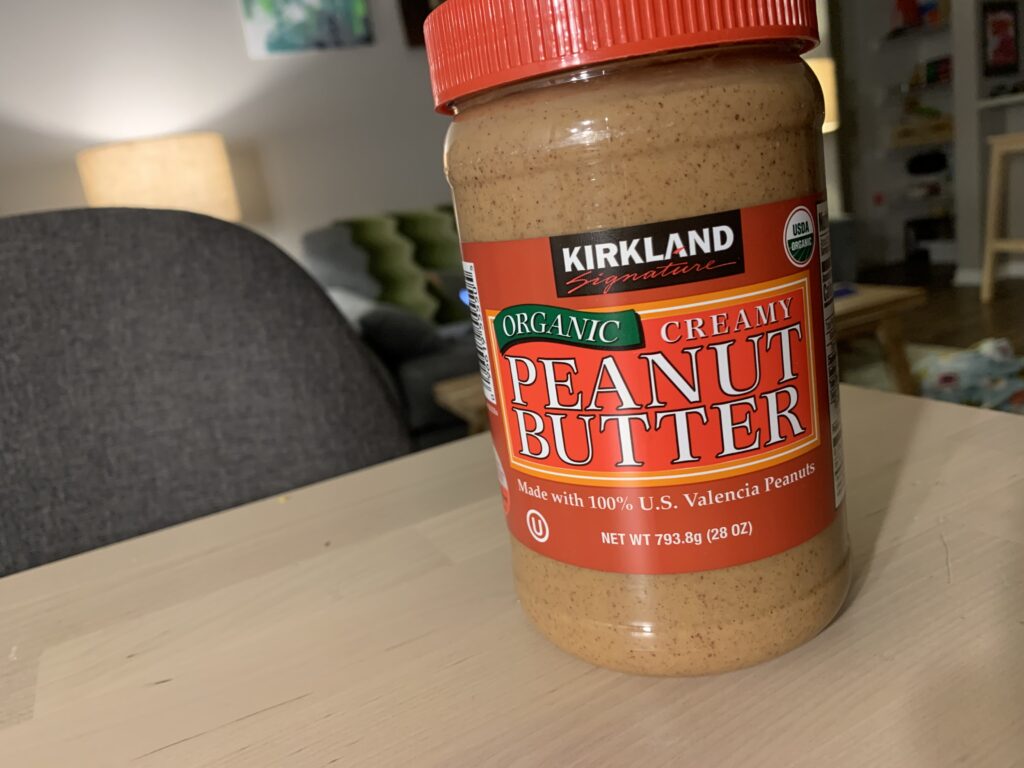
Much like suet, peanut butter is a fun, high-fat treat to offer birds, especially in the winter. The Cornell Bird lab says grocery store peanut butter is safe to feed for birds, you may want to avoid serving it in the summer as it spoils quickly. You can also add some cornmeal to your bird peanut butter to make it easier for birds to consume.
Birds that like it
- Brown Creeper
- Chickadees
- Nuthatches
- Woodpeckers
- Titmice
- Warblers (on-occasion)
Price: $$
Safflower Seed
Safflower is a great option for bird feeding, especially if you’re having problems with squirrels and pest birds. This is often labeled as a “problem solver” seed for many birders! Safflower seed is bitter and doesn’t appeal to squirrels. It also has a thick shell, making it hard for annoying birds like House Sparrows, Starlings and Grackles to get into.

You’ll often find safflower combined with sunflower seed to create “Cardinal blends” of birdseed. But you can also buy it solo (link above).
It’s a little pricey, but I’ve seen Cardinals go especially bananas for golden safflower seed, which has slightly higher oil, fat, and protein content compared to white-shelled safflower.
Birds that like it
- Cardinals
- Chickadees
- Doves
- Finches
- Grosbeaks
- Titmice
Price: $$$
Seed Cylinders
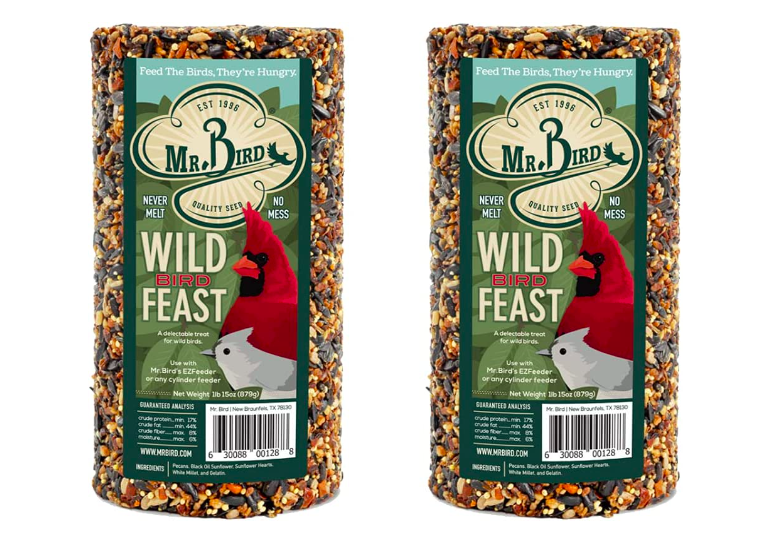
You can buy seed cylinders online and from local bird retailers like Wild Birds Unlimited. This is another great no-mess option. Some bird stores also sell these in fun shapes like owls. You just need a cylinder feeder and you can plop one of these on it. Quick and easy!
A bonus: Seed cylinders are harder for pesky birds like Grackles, House Sparrows and Starlings to eat from!
Birds that like it:
- Cardinals
- Chickadees
- Grosbeaks
- Nuthatches
- Woodpeckers
Price: $$$
White Millet
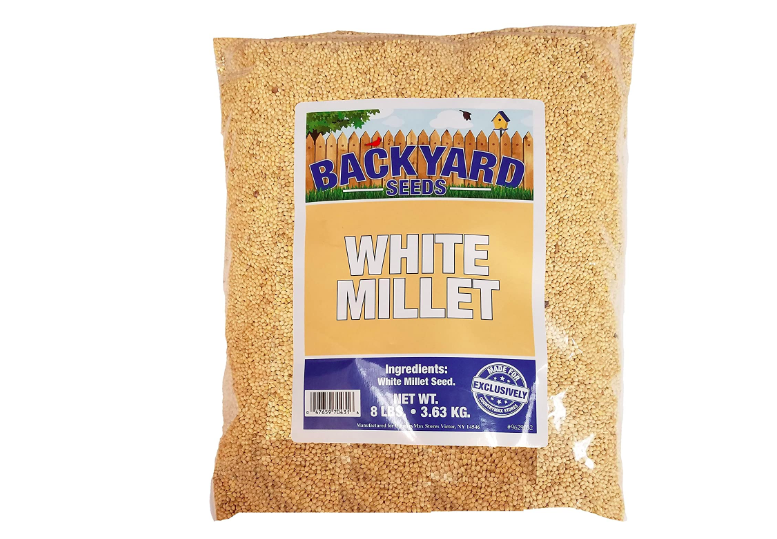
White millet is a small round grain and I view it as a double-edged sword. On the one hand, it’s beloved by birds like mourning doves, red-winged blackbirds, native sparrows, juncos, and indigo bunting when they’re migrating in the spring. But…it’s also beloved by the invasive house sparrow.
My advice is to sprinkle millet on the ground or add a little bit of to your regular bird feed in the spring, fall, and winter to draw in desirable birds. Millet is also really cheap…so it has that going for it. Avoid serving it in the summer. I’ve found it doesn’t draw in too many unique birds other than house sparrows at that time of year.
Price: $
Suet
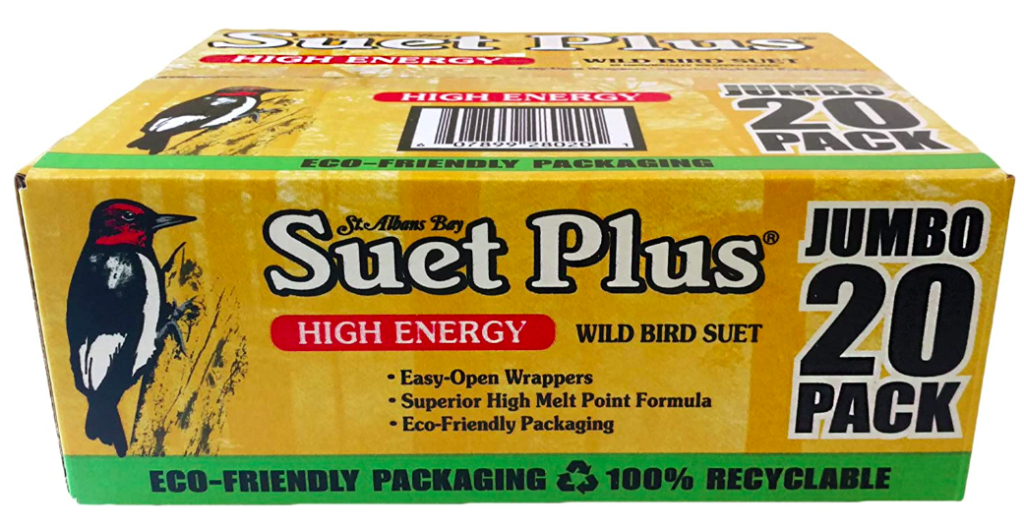
I love suet for bird feeding. It’s a simple way to draw in woodpeckers on the regular. Suet is cheap. It costs $1 to $5 for a cake of it, which usually lasts me for a couple of weeks. You can also buy suet logs for a tree log feeder. This is what I do! Woodpeckers absolutely love it.
Birds that like it
- Chickadees
- Jays
- Nuthatches
- Tanagers (sometimes)
- Woodpeckers
- Wrens (on occasion)
Price: $
A word of caution: European Starlings are also fond of suet. To discourage them from eating it all up, you can invest in an upside-down suet feeder. Starlings have trouble hanging from it, but woodpeckers and smaller birds like chickadees won’t have a problem getting to it.
Sugar Water (Nectar)
There are hummingbird nectars you can buy from the store, but don’t waste your time or money! It’s simple and cheap to make your own from home. All you need is white table sugar and water. That’s it.
Here’s a post on how to make hummingbird nectar from home.
Be sure to wash nectar feeders every day in the hot summer months. It can harbor bacteria and mold in a hurry, which is harmful for birds.
Birds that like it
- Hummingbirds
- Orioles
- Woodpeckers (on occasion)
Price: $
Sources:
Disclaimer: Some links found on this page might be affiliate links. If you click an affiliate link and make a purchase, I might earn a commission. As an Amazon Associate I earn from qualifying purchases.

This is great thanks
Thank you, Laura!
Pingback:In Defense of the Brown Headed Cowbird - BIRD BITES
Pingback:5 Time-Tested Ways to Attract Cardinals to Your Bird Feeder - BIRD BITES
Pingback:The Ultimate Guide to Attract Woodpeckers to Your Bird Feeders - BIRD BITES
Pingback:The Best Bird Seeds on Amazon (Top 10 List) - BIRD BITES
Pingback:10 Birds that Love Eating Mealworms (With Photos) - BIRD BITES
Pingback:5 Tips to Attract Chickadees to Your Bird Feeder, Guaranteed! - BIRD BITES
Pingback:How to Save Money While Bird Feeding - BIRD BITES
Pingback:22 Unique Cardinal Facts You Didn’t Know About - BIRD BITES
Pingback:Red Milo Sucks in Bird Seeds (Do Any Birds Eat It?) - BIRD BITES
Pingback:Why Aren’t Birds Coming to My Feeder? 6 Reasons and How to Fix Them - BIRD BITES
Pingback:10 of the Most Unique Bird Feeders Found on Amazon - BIRD BITES
Pingback:Four Foods to Avoid Feeding Birds – What you Need to Know - BIRD BITES
Pingback:The Most Common Bird Feeding Mistakes Beginners Make and How to Avoid Them - BIRD BITES
Pingback:Wildlife Sciences Suet Plugs Review: A Go-To Winter Food for Woodpeckers - BIRD BITES